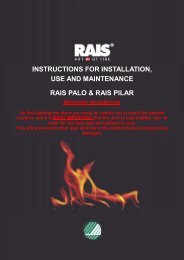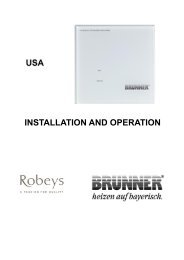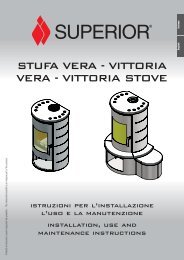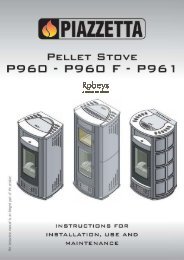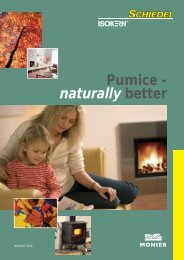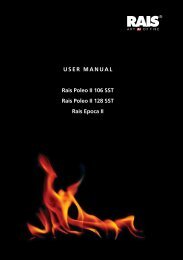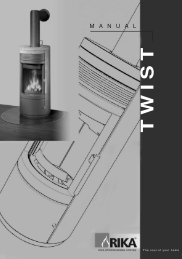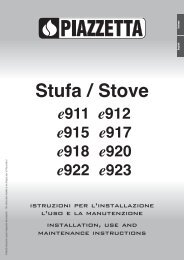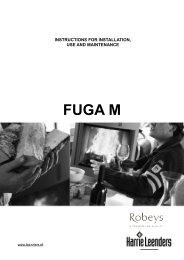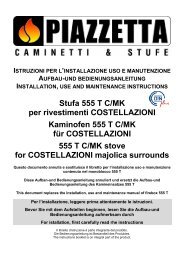USER MANUAL RAIS 500 - Robeys Ltd
USER MANUAL RAIS 500 - Robeys Ltd
USER MANUAL RAIS 500 - Robeys Ltd
Create successful ePaper yourself
Turn your PDF publications into a flip-book with our unique Google optimized e-Paper software.
English <strong>RAIS</strong> - manual for <strong>RAIS</strong> <strong>500</strong><br />
Convection<br />
<strong>RAIS</strong> stoves are convection stoves. This means that the stove’s back and side panels are<br />
not over-heated. Convection means that there is a circulation of air, which ensures that<br />
the heat is distributed more evenly throughout the entire room. The cold air is sucked in<br />
at the base of the stove up through the convection channel, which runs along the stove’s<br />
combustion chamber. The heated air pours out at the top of the stove, which ensures a<br />
circulation of warm air throughout the room.<br />
The stoves are equipped with “cold” door handles – <strong>RAIS</strong> special feature – which means<br />
you could almost do away with gloves. Be aware, however, that all exterior surfaces become<br />
hot during use - so take extreme care.<br />
Chimney<br />
The chimney is the driving force which makes the stove function. In order for the stove to<br />
perform satisfactorily the chimney height must be sufficient to ensure the correct draught<br />
of 14 to 18 Pa so as to clear the products of combustion and prevent problems of smoke<br />
emanating into the room when firing.<br />
NOTE: A chimney height of not less than 4.5 metres measured vertically from the outlet<br />
of the stove to the top of the chimney should be satisfactory. Alternatively the calculation<br />
procedure given in BS 5854:1980 may be used as the basis for deciding whether a<br />
particular chimney design will provide sufficient draught.<br />
The outlet from the chimney should be above the roof of the building in accordance with<br />
the provisions of Building Regulations Approved Document J.<br />
If installation is into an existing chimney then it must be sound and have no cracks or<br />
other faults which might allow fumes into the house. Older properties, especially, may<br />
have chimney faults or the cross section may be too large i.e. more than 230 mm x 230<br />
mm. Remedial action should be taken, if required, seeking expert advice, if necessary. If it<br />
is found necessary to line the chimney then a flue liner suitable for solid fuel must be used<br />
in accordance with Building Regulations Approved Document J.<br />
Any existing chimney must be clear of obstruction and have been swept clean immediately<br />
before installation of the stove. If the stove is fitted in place of an open fire then the<br />
chimney should be swept one month after installation to clear any soot falls which may<br />
have occurred due to the difference in combustion between the stove and the open fire.<br />
If there is no existing chimney then either a prefabricated block chimney in accordance<br />
with Building Regulations Approved Document J or a twin walled insulated stainless steel<br />
flue to BS 4543 can be used. These chimneys must be fitted in accordance with the manufacturer’s<br />
instructions and Building Regulations.<br />
PRELEMINARY<br />
7



